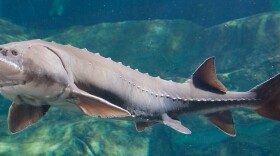One of the most ancient species in the Great Lakes is the sturgeon. The fish has been around since the time of the dinosaurs, and was once abundant in all five lakes.
But, like many species, its numbers nosedived thanks to overfishing and habitat destruction.
Ed Bakeris research station manager at the Marquette Fisheries Research Station of the Department of Natural Resources. He joined Stateside to talk about efforts to restore the region’s sturgeon population.
Baker said initially, sturgeon were considered a nuisance fish by fisherman, who would would kill sturgeon that ended up in nets along with whitefish and lake trout. But eventually, Baker said, the industry realized the fish had commercial value.
“At a point in the late 1800s, commercial fisheries began targeting sturgeon for their flesh, and for their eggs which could be turned into caviar,” he explained.
Listen above to learn what led to the decline of the sturgeon in the Great Lakes, why the species faces some big hurdles in recovery, and the sturgeon’s potential as a predator for invasive species.
(Subscribe to the Stateside podcast on iTunes, Google Play, or with this RSS link)





